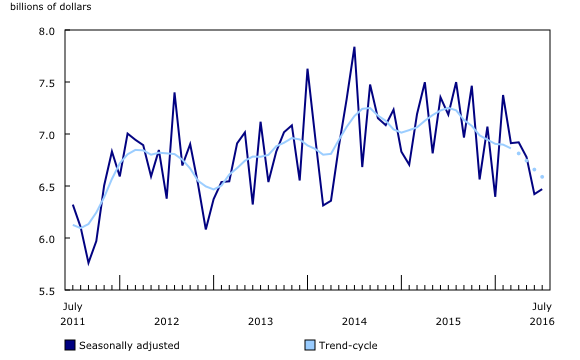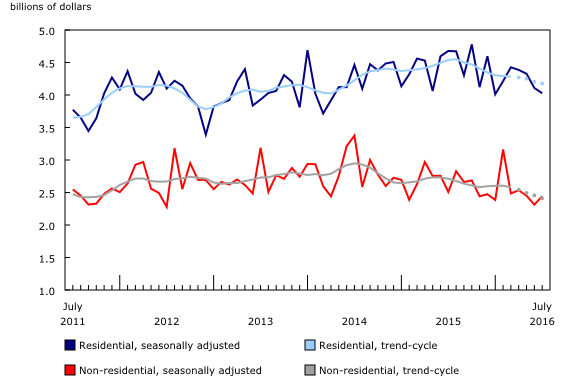Building permits, July 2016
Archived Content
Information identified as archived is provided for reference, research or recordkeeping purposes. It is not subject to the Government of Canada Web Standards and has not been altered or updated since it was archived. Please "contact us" to request a format other than those available.
Released: 2016-09-08
$6.5 billion
July 2016
0.8% 
(monthly change)
$35.1 million
July 2016
-16.2% 
(monthly change)
$20.8 million
July 2016
-10.2% 
(monthly change)
$78.8 million
July 2016
21.9% 
(monthly change)
$63.1 million
July 2016
-39.7% 
(monthly change)
$1,094.4 million
July 2016
-10.1% 
(monthly change)
$2,843.6 million
July 2016
11.1% 
(monthly change)
$230.0 million
July 2016
17.6% 
(monthly change)
$157.8 million
July 2016
-44.3% 
(monthly change)
$951.0 million
July 2016
7.4% 
(monthly change)
$980.8 million
July 2016
-4.8% 
(monthly change)
$5.1 million
July 2016
6.9% 
(monthly change)
$5.7 million
July 2016
-45.2% 
(monthly change)
$3.8 million
July 2016
...%
(monthly change)
Municipalities issued building permits worth $6.5 billion in July, up 0.8% from the previous month. The advance was largely the result of higher construction intentions for institutional and industrial buildings. Ontario and Alberta led the national increase.
In the non-residential sector, the value of building permits advanced 5.6% to $2.4 billion. The gain followed two consecutive months of declines. Increases were reported in four provinces, most notably Ontario.
The value of residential building permits was down 2.0% to $4.0 billion in July, the fourth consecutive monthly decrease. Lower construction intentions were posted in five provinces, with British Columbia, Ontario and Quebec leading the decline.
Non-residential sector: Higher construction intentions in all components
In July, all three non-residential components posted higher construction intentions, with institutional structures leading the advance, followed by industrial buildings.
The value of permits for institutional buildings rose 9.6% to $740 million in July, the third increase in four months. The advance was largely the result of higher construction intentions for medical facilities and, to a lesser extent, retirement residences. Gains in Ontario offset declines observed in six provinces, led by Saskatchewan.
In the industrial component, the value of permits advanced 17.1% to $418 million, following five consecutive monthly declines. The increase stemmed from higher construction intentions for transportation terminals and, to a lesser degree, maintenance-related buildings. The value of building permits was up in four provinces, most notably Ontario, followed by Alberta and Manitoba.
The value of commercial building permits edged up 0.3% to $1.3 billion in July. Higher construction intentions for office buildings and retail complexes were mostly responsible for the gain. Increases were registered in seven provinces, with Ontario reporting the largest advance.
Residential sector: Single-family dwellings report the largest decline
The value of permits for single-family dwellings declined 3.0% to $2.4 billion in July, following a 4.8% increase in June. Every province, except Nova Scotia and Manitoba, posted a decrease. The largest drop was reported in Ontario, followed by British Columbia and Alberta.
Construction intentions for multi-family dwellings edged down 0.4% to $1.7 billion in July, the fifth decline since the beginning of 2016. The value of permits was down in four provinces, with British Columbia and Quebec reporting the largest decreases.
Municipalities approved the construction of 15,388 new dwellings in July, 2.2% more than in June, when the number of new units approved was at its lowest since December 2012. The advance in July was attributable to multi-family dwellings, up 3.9% to 9,652 new units. In contrast, the number of single-family homes declined 0.5% to 5,736 new dwellings.
Provinces: Ontario posts the largest increase
In July, higher construction intentions were reported in four provinces, led by Ontario, followed by Alberta and Manitoba.
The value of building permits in Ontario was up 11.1% to $2.8 billion, following an 8.2% decline in June. The gain was attributable to higher construction intentions for non-residential buildings, led by institutional structures, followed by commercial and industrial buildings. The advance was moderated by a 2.6% decrease in the value of residential dwelling permits.
Following two consecutive monthly declines, the value of building permits in Alberta rose 7.4% to $951 million in July. All components were up, except single-family dwellings. The gain was largely the result of higher construction intentions for multi-family dwellings and industrial buildings.
In Manitoba, the value of building permits increased 17.6% to $230 million. Every component registered a gain, led by industrial buildings and multi-family dwellings.
Conversely, Saskatchewan and Quebec posted the largest declines. In Saskatchewan, the value of building permits was down 44.3%, offsetting the notable advance in June. In Quebec, the 10.1% drop followed two consecutive monthly increases.
Census metropolitan areas: Toronto registers the most significant advance
In July, the value of building permits was up in 14 of the 34 census metropolitan areas. The largest increases were registered in Toronto and Ottawa.
In Toronto, the value of permits rose 18.5% to $1.5 billion. Every component, except single-family dwellings, posted a gain. Higher construction intentions for institutional and commercial buildings were largely responsible for the advance.
The value of building permits in Ottawa was up 58.0% to $339.4 million in July, a second consecutive monthly increase. While every component registered a gain, higher construction intentions for multi-family dwellings led the advance.
In contrast, Saskatoon recorded the largest decrease (-68.1%), following three consecutive monthly increases. While lower construction intentions were reported for all components, institutional buildings accounted for most of the decline.
Note to readers
Unless otherwise stated, this release presents seasonally adjusted data, which facilitates comparisons by removing the effects of seasonal variations. For more information on seasonal adjustment, see Seasonally adjusted data – Frequently asked questions.
The Building Permits Survey covers over 2,400 municipalities, representing 95% of the Canadian population. The communities representing the other 5% of the population are very small and their levels of building activity have little impact on the total for the entire population.
Building permits data are used as a leading indicator of activity in the construction industry.
The value of planned construction activities shown in this release excludes engineering projects (for example, waterworks, sewers or culverts) and land.
For the purpose of this release, the census metropolitan area of Ottawa–Gatineau (Ontario/Quebec) is divided into two areas: Gatineau part and Ottawa part.
Unless otherwise specified, the highlights refer to seasonally adjusted current dollars and are ranked in terms of dollar change rather than percentage change.
Revision
Data for the current reference month are subject to revision based on late responses. Data for the previous month have been revised.
Trend-cycle estimates have been added to the charts as a complement to the seasonally adjusted series. Both the seasonally adjusted and the trend-cycle estimates are subject to revision as additional observations become available. These revisions could be large and even lead to a reversal of movement, especially at the end of the series. The higher variability associated with the trend-cycle estimates is indicated with a dotted line on the chart.
For information on trend-cycle data, see the StatCan Blog and Trend-cycle estimates – Frequently asked questions.
Next release
The August building permits data will be released on October 6.
Products
The July 2016 issue of Building Permits (64-001-X) will soon be available.
Contact information
For more information, contact us (toll-free 1-800-263-1136; 514-283-8300; STATCAN.infostats-infostats.STATCAN@canada.ca).
To enquire about the concepts, methods or data quality of this release, contact Monia Bergeron (613-286-5152; monia.bergeron@canada.ca), Investment, Science and Technology Division.
- Date modified:



